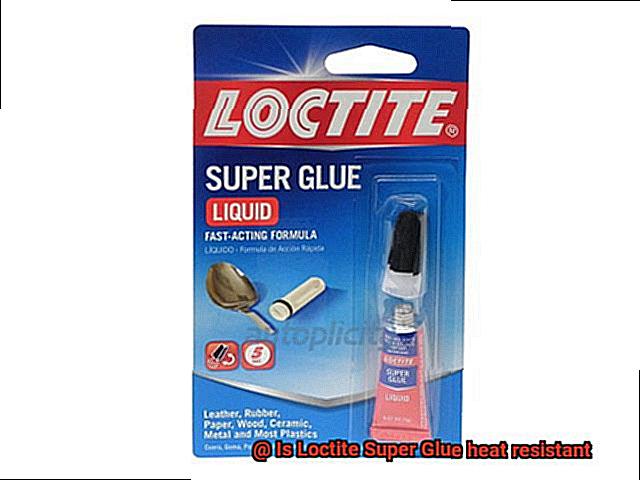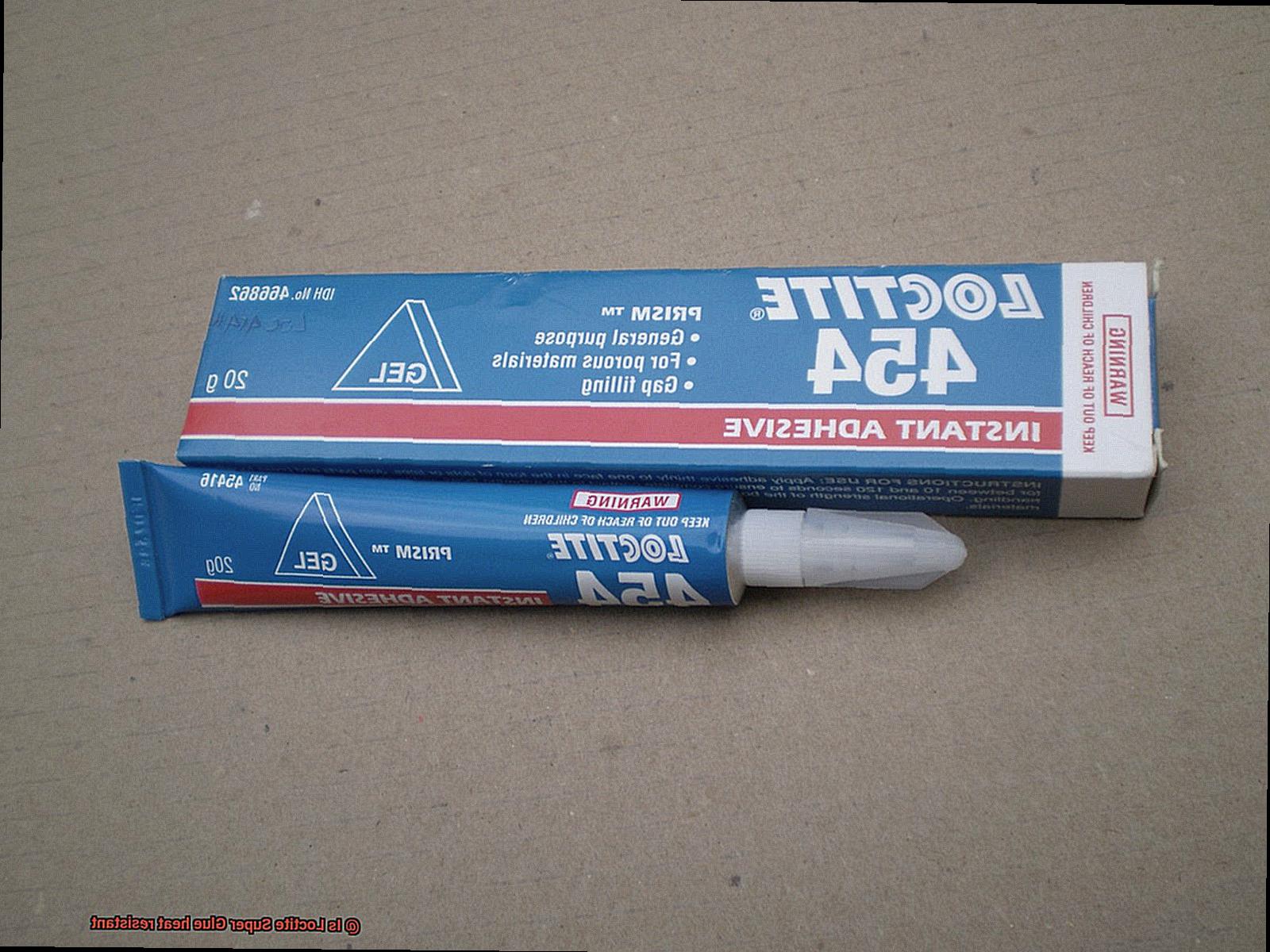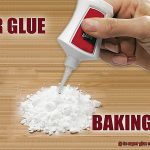Finding the perfect adhesive for your sizzling projects can be a real headache. But fear not, because we’ve got a contender that claims to conquer all – Loctite Super Glue. This trusty brand boasts about its ability to bond just about anything effortlessly. But can it really handle the heat?
In this blog post, we’re diving headfirst into the world of heat-resistance to uncover the truth behind Loctite Super Glue’s claims. Whether you’re curious if it can withstand scorching sunlight, brave oven temperatures like a champ, or take on industrial heat applications with ease, we’ve got all the answers you need.
Join us as we unravel the science behind Loctite Super Glue’s heat resistance, expose its limitations, and dish out some insider tips for maximizing its performance in those fiery situations.
Heat Resistance Capabilities of Loctite Super Glue
Contents
Loctite Super Glue is renowned for its exceptional bonding strength; however, it is vital to understand its limitations when it comes to heat resistance. In this article, we will delve into the heat resistance capabilities of Loctite Super Glue, discuss its constraints, and explore alternative adhesive options for high-temperature applications.
Heat Resistance Limitations:
While Loctite Super Glue boasts impressive bonding properties, it is not specifically designed to endure extreme temperatures. The regular formula of this adhesive can begin to lose its effectiveness when exposed to temperatures exceeding 176°F (80°C). In higher temperatures, the glue may become brittle and emit harmful fumes that compromise the strength of the bond.
Alternative Adhesive Options:
For projects requiring heat resistance, specialized adhesives tailored for such applications are recommended. These adhesives are formulated with unique chemical compositions that allow them to remain stable and maintain their bonding properties even in extreme heat conditions.
Consider the following alternative adhesive options for high-temperature applications:
- Epoxy Adhesives: Known for their excellent heat resistance, epoxy adhesives can withstand temperatures of up to 300°F (149°C).
- Silicone Adhesives: Silicone adhesives offer good heat resistance and can endure temperatures up to 400°F (204°C). They are commonly utilized in automotive and electronic applications.
- Heat-Resistant Formulations: Specialty glues specifically designed for high-temperature applications are available. These glues exhibit impressive capabilities, with some being able to withstand temperatures ranging from 500°F (260°C) to over 2000°F (1093°C), depending on the specific product.
Precautions and Considerations:
When using Loctite Super Glue or any adhesive, it is crucial to carefully read the manufacturer’s instructions and guidelines. The packaging or manufacturer’s website should provide specific information regarding the heat resistance capabilities of the glue. If uncertainty arises regarding the suitability of Loctite Super Glue for a particular high-temperature application, it is advisable to consult with a professional or contact the manufacturer directly for guidance.
Temperature Limitations for Loctite Super Glue
With its formidable bonding properties and versatility, it’s no wonder that this adhesive is a go-to choice. However, even the mightiest glues have their limits when it comes to temperature resistance. So, let’s dive into the world of temperature limitations and explore what you need to know about using Loctite Super Glue in different temperature conditions.
First things first, it’s important to note that the temperature limitations of Loctite Super Glue can vary depending on the specific formulation of the glue. To get precise information on temperature resistance, refer to the product’s technical data sheet or packaging. As a general guideline, most Loctite Super Glue products are designed to withstand temperatures ranging from -50°C (-58°F) to 120°C (248°F) once fully cured. However, keep in mind that these temperature ranges may differ for different formulations.
Now, let’s talk extremes. At bone-chillingly low temperatures, Loctite Super Glue may become brittle and lose its bonding strength. So, it’s not advisable to use the glue in applications where it will be subjected to freezing temperatures. On the other hand, at scorching temperatures approaching or exceeding the upper limit of the temperature range, Loctite Super Glue may soften or even melt. This unfortunate turn of events can lead to a loss of adhesion—something you definitely want to avoid in heat-sensitive situations like automotive or industrial settings.
But wait, there’s more. The temperature resistance of Loctite Super Glue can also be influenced by factors such as the surface type and condition, the amount of adhesive applied, and the duration of exposure to extreme temperatures. So, it’s essential to consider these factors when using the glue.
If you find yourself needing a higher temperature resistance than what standard Loctite Super Glue offers, fear not. Loctite has a range of specialized high-temperature adhesives that are formulated to withstand more demanding temperature conditions. These exceptional adhesives provide reliable bonding performance even at elevated temperatures, making them perfect for those hot and intense applications.
Adverse Effects of Excessive Heat on Loctite Super Glue
Loctite Super Glue, our trusty adhesive superhero, may have a weakness after all – excessive heat. So, why does heat have such a villainous effect on our beloved glue?
When exposed to high temperatures, the chemical composition of Loctite Super Glue undergoes a transformation that can wreak havoc on its adhesive properties. As a result, its ability to stick things together decreases, and we certainly don’t want our carefully crafted projects falling apart.
But that’s not all. Excessive heat can cause the glue to lose its flexibility and become brittle. It’s like witnessing your favorite superhero losing all their powers and becoming as fragile as glass. The glue becomes more susceptible to cracking and breaking, which is definitely not what we need.
And now, things start to melt – quite literally. The heat can cause the glue to liquefy or melt entirely, weakening the bond or causing it to fail altogether. Picture your favorite superhero turning into a puddle of goo – not a pretty sight, I must say.
But fret not. There are ways to prevent this villainous heat from ruining your bonding adventures. Store your Loctite Super Glue in a cool and dry place, far away from direct sunlight or any sources of high temperatures. And if you suspect that your glue has been exposed to excessive heat, it’s always wise to test its adhesive strength before using it for any critical applications.
Alternative Adhesive Options for High Temperature Applications
While Loctite Super Glue is a faithful companion for bonding, when faced with extreme heat, it’s time to summon reinforcements.
First on our roster of alternative heroes is epoxy. Renowned for its ability to withstand high temperatures and forge robust bonds, epoxy adhesives are the go-to choice in industries like aerospace, automotive, and electronics. These adhesives possess an unrivaled resilience against scorching conditions, ensuring your projects remain intact.
Next up is silicone adhesive, a true champion in heat resistance. With exceptional temperature tolerance and the capacity to endure sizzling temperatures of up to 500°F (260°C) or higher, silicone adhesives prove perfect for HVAC systems, electrical components, and any application where heat exposure is expected. Bid farewell to adhesive meltdowns.
For those working with ceramics, glass, or metals in extreme heat, ceramic adhesives reign. These specially formulated adhesives can withstand mind-boggling temperatures of up to 2000°F (1093°C) or beyond. Whether you’re bonding rocket parts or crafting exquisite ceramic sculptures, ceramic adhesives have got you covered.
But wait, there’s more. In certain cases, specialty heat-resistant tapes or films might be your salvation. Fashioned from materials like PTFE (polytetrafluoroethylene) or Kapton, these tapes and films retain their adhesive properties even in the face of blistering temperatures. They are the superheroes of the adhesive world, poised to rescue you in any high temperature predicament.
Remember that selecting the perfect alternative adhesive option depends on factors such as maximum temperature exposure, bonded materials, and desired bond strength. Each option possesses its own strengths and considerations, making it wise to consult adhesive experts.
How to Choose the Right Adhesive for Your Project
When embarking on a project, selecting the right adhesive is crucial to ensure a successful outcome. With a plethora of options available, it can be overwhelming to determine which adhesive will best suit your needs. Fear not, as I am here to guide you through the intricate world of adhesives and help you choose the perfect one for your project.
Consider Material Compatibility:

One of the most important factors to consider when selecting an adhesive is material compatibility. Different adhesives work better on certain materials, so it is essential to choose one that will bond effectively with the surfaces you are working with. For instance, if you are bonding wood or fabric, look for an adhesive that can penetrate and create a strong bond with these porous materials.
Evaluate Application Method:
The method of application is another critical consideration in adhesive selection. Some adhesives come in liquid form and require precise application using a brush or nozzle, while others are available in tape or gel form for easier and less messy application. Take into account the size and shape of the objects you are bonding and select an adhesive that offers convenient and accurate application.
Assess Environmental Conditions:
Environmental conditions can greatly impact the performance of an adhesive. If your project will be exposed to extreme temperatures or high humidity, it is vital to choose an adhesive that can withstand these conditions. Look for adhesives specifically designed to be heat resistant or moisture-proof, ensuring that your project remains intact even in challenging environments.
Determine Strength and Durability:
Consider the strength and durability requirements of your project when selecting an adhesive. Different adhesives offer varying levels of bond strength, so it is crucial to choose one that can withstand the stress and strain your project will endure. Whether you need a temporary bond or a long-lasting connection, there is an adhesive available to suit your needs.
Test Before Committing:
Before fully committing to an adhesive, it is always wise to conduct a test. Apply a small amount of adhesive to a sample material or scrap piece and allow it to dry and cure. This will give you a firsthand experience of how well the adhesive bonds and whether it meets your expectations in terms of strength and durability. Testing ensures that you have chosen the right adhesive before embarking on your project.
-bwjyPhEACk” >
Also Read: Is Loctite Power Grab Waterproof? – Glue Things
Conclusion
In conclusion, Loctite Super Glue is a dependable adhesive for many tasks. However, it does have limitations when it comes to heat resistance. When exposed to temperatures exceeding 176°F (80°C), the regular formula of Loctite Super Glue may start to lose its effectiveness. At higher temperatures, the glue can become brittle and release harmful fumes that weaken the bond.
For projects that require heat resistance, it’s best to explore alternative adhesive options. Epoxy adhesives are renowned for their outstanding ability to withstand heat, withstanding temperatures up to 300°F (149°C). Silicone adhesives also offer good heat resistance and can endure temperatures up to 400°F (204°C). Additionally, there are specialty glues specifically designed for high-temperature applications, capable of handling temperatures ranging from 500°F (260°C) all the way up to over 2000°F (1093°C), depending on the specific product.
It’s crucial to carefully review the manufacturer’s instructions and guidelines when using any adhesive, including Loctite Super Glue. The packaging or manufacturer’s website should provide detailed information about the glue’s heat resistance capabilities. If you’re unsure about whether Loctite Super Glue is suitable for a particular high-temperature project, it’s wise to seek advice from a professional or reach out directly to the manufacturer.
Remember, selecting the right adhesive for your project involves considering various factors such as material compatibility, application method, environmental conditions, strength requirements, and durability needs. Conducting tests before committing is also essential.






